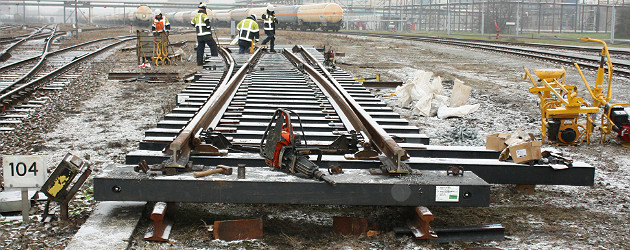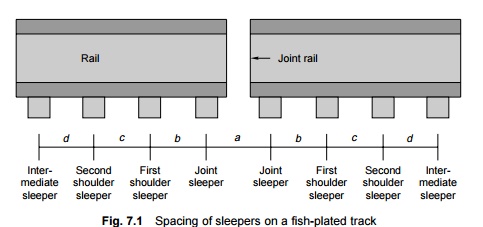In this article, we will study the role of sleepers in the railways. We shall also discuss the merits, demerits, and functions of sleepers in railways.
Table of Contents
Sleepers
The components that are placed over the ballast and under the rails for fixed support so that the load could transfer from rails to the ballast are known as sleepers. They are also known as railroad or cross ties.
In this picture, you can see that the heavy axial load from the wheels acting on the rails and then on the sleepers, then sleepers will transfer this load to ballast and then on the formation or sub-grade. It also shows that sleepers have a very significant role while the transferring of load.
Functions of Sleepers
These are some of the main functions of sleepers.
- One of the main functions of the sleepers is to provide firm support to the rails.
- It acts as a medium for transferring the loads.
- It enables the railway track to get stable longitudinally and laterally.
- It provides a uniform distribution of load.
- It also retards the effect of vibrations generated from the rails.
- Provide a proper path for the railway track.
Requirements of an Ideal Sleeper
- It should require minimal cost for its maintenance.
- Easy to place and remove.
- Its weight should be in the medium range so that it would be easy to handle.
- It should have enough bearing strength to protect the ballast from crushing.
- Its fastenings should be feasible for the rail’s replacement.
- It should be vibration-resistant.
Types of Sleepers
There are some of the main types of sleepers. We will discuss each type with its details.
- Wooden sleepers
- Cast iron sleepers
- Steel sleepers
- Concrete sleepers
- Composite sleepers
1)Wooden Sleepers
The sleepers made of wooden elements are called wooden sleepers. Timber is used for the manufacturing of wooden sleepers. It is considered as best type because it satisfies all the conditions of an ideal sleeper. It has a low initial cost while its maintenance cost is very high.

a)Hardwood sleepers
- They are durable and long-lasting
- Generally made up of oak, teak wood, and jar rah
- Don’t need treatment like softwood sleepers
- They are denser than softwood sleepers
b)Softwood sleepers
They are more resistant than hardwood sleepers, but they do not provide resistance to the enlargement of spike holes.
- They are also not suitable for gauge adjustments
- They are generally applicable for open deck bridges
Advantages of Wooden sleepers
Some of the advantages of wooden sleepers are as follows:
- Easy manufacturing due to its availability
- Suitable for all types of routes
- Do not cause damage to the ballast
- It can resist vibrations and shocks
- Provide an easy ride to the passengers
- Low initial cost
- Conventional fastening
- Appropriate for track circuited areas
Disadvantages of Wooden sleepers
Some of the disadvantages of wooden sleepers are as follows:
- Its service life is too short
- It can be worn or get decay easily
- They have a negligible scrap value
- Affected by climatic conditions
- It does not resist fire
- It has a high maintenance cost
- Difficult gauge adjustment
- Don’t resist white ants attack
Treatment of Wooden sleepers
Treatment of wooden sleepers is very essential to enhance their service life.
- By using different types of preservatives
- Air seasoning helps to reduce the moisture level
- By using creosote oil, salt solution (Zn Cl2), and mercury bi-chloride (Hg Cl2)
2)Cast Iron Sleepers
These sleepers are widely available in the railways of India. Their manufacturing member is cast iron. It has some types:
- Pot type sleepers
- Plate type sleepers
- Box type sleepers

Advantages of Cast Iron sleepers
- It has a low maintenance cost
- This type of sleeper is easy to handle due to its light-weight
- Its service life is about 50-60 years better than wooden sleepers
- It has good scrap value
- Elastic fastening is applicable
- It has also easy gauge adjustment
Disadvantages of Cast Iron sleepers
- It is not preferable for high-speed routes
- Do not resist corrosion and shock absorption
- Not preferable for coastal areas
- Easy breakage due to brittle nature
- It requires numerous fastenings
- Require proper maintenance
- Its initial cost is high
3)Steel Sleepers
These types of sleepers are much stronger than wooden sleepers due to their strength. Their manufacturing components are steel members. After the wooden sleepers, these are the most successful sleepers. It also has the modern structure than the previous ones. It consists of two types:
- Key-type sleepers
- Nut and Bolts type sleepers
Advantages of Steel sleepers
- These are applicable for all types of routes.
- Its maintenance cost is also low
- It has a long life span
- They are more reliable than other sleepers
- It has high resistance against fire and creeps
- Required less ballast
- Its installation is accessible
- It is also profitable than concrete sleepers
- Smooth gauge adaption
- Good scrap value
Disadvantages of Steel sleepers
- High initial cost
- Do not resist corrosion
- It is not appropriate for all types of ballast
- Affected by the chemicals
- Not Appropriate for track circuited areas
- It is also not applicable for all rail sections
4)Concrete Sleepers
These sleepers are widely used for railway tracks due to their high strength and ability to resist shear damage. Their manufacturing components are cement, sand, and reinforcement bars that are locally available.
Concrete sleepers are also known as R.C.C sleepers due to the presence of reinforcement in them. These steel bars make them more durable. Two types of concrete sleepers those are mostly available in railways.
- Mono-block concrete sleepers
- Twin block concrete sleepers
Advantages of Concrete sleepers
- It has a service life of 40-50 years.
- It requires an easy manufacturing process
- Having less maintenance cost
- Only elastic fastening is used for these sleepers
- Resistant to buckling and corrosion
- Appropriate for track circuited areas
Disadvantages of Concrete sleepers
- Its heavy-weight is the main drawback
- Installation is not smooth to handle
- Uneconomical due to high cost of construction
- Vulnerable to getting damaged during placing of sleepers
- There is no scrap value for concrete sleepers
- Chances to break during transportation
5)Composite Sleepers
It is one of the modern types of sleepers. Their manufacturing components are recycled materials like rubber, waste plastic and waste tires, etc. These are also known as Plastic sleepers. Their cost is 50% less than the wooden sleepers. Their workability is more accurate than the concrete sleepers.
Their weight is also lighter than concrete sleepers and can be organized at any length. These sleepers are reinforced by long glass fibers that are responsible for their strength and stiffness.
Advantages of Composite sleepers
- It serves for a life period of about 50 years
- They are not harmful to the environment
- More stable. Less wear and tear and cause less noise during movements
- Required low maintenance cost
- Their scrap value is also appreciable
- Preservation of resources up to 80%
- They are resistant to corrosion and shock absorption
Demerits of Composite sleepers
- They are not resistant to fire
- Its cost is increasing due to higher demand
- A complete design guideline is not available for composite sleepers
- It contains low strength and stiffness due to short of no fiber reinforcement
Density of Sleepers
The number of sleepers required for a single rail track is known as the density of the sleepers. The density of sleepers can be shown as:
Density of sleeper = (N + x)
Where N is the length of the rail in meters or x can vary from 3 to 6. We can better understand the density of sleepers by solving an example.
Example
If the length of the rail is 13 m and the number of sleepers required for this length is 19 then we can compute the density of the sleepers as:
N = 13
Sleeper density = N + x = 19
Then in terms of (N+x),
The density of the sleepers will be = (N + 6)
- It ranges from (N + 3) to (N + 7) in Pakistan
- It ranges from (N + 9) to (N + 11) in America
Spacing of Sleepers
The spacing of sleepers is mainly dependent upon the density of the sleepers.
- The spacing of the sleepers is less where there is a risk of damage.
- The spacing is not uniform between the sleepers, but it should be moderate on a railway track.
- It also depends upon the type or the number of loads acting on the rails.
Also read: Defects in Rails











